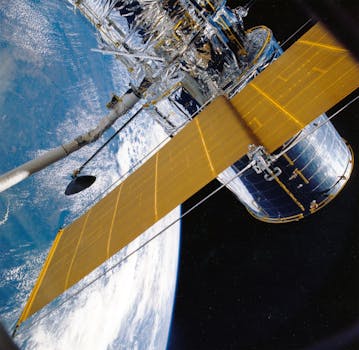
Updates from Above: Essential Insights into the Latest in Satellite Telecommunications
Satellite Telecommunications
Satellite telecommunications is a vital component of modern communication systems, enabling global connectivity and facilitating the exchange of information across the world. With the rapid advancement of technology, the satellite telecommunications industry has undergone significant transformations in recent years. In this article, we will delve into the latest updates and insights in the field of satellite telecommunications, exploring the current trends, challenges, and future prospects.
One of the most significant developments in satellite telecommunications is the launch of new satellite constellations, such as the Starlink constellation by SpaceX and the OneWeb constellation. These constellations consist of thousands of small satellites in low Earth orbit, providing high-speed internet connectivity to remote and underserved areas. The launch of these constellations has sparked a new era of competition in the satellite telecommunications industry, with several companies vying for market share.
Advancements in Satellite Technology
Recent advancements in satellite technology have enabled the development of more efficient and powerful satellites. The use of advanced materials and designs has led to the creation of smaller, lighter, and more fuel-efficient satellites, which can be launched at a lower cost. Additionally, the development of new propulsion systems, such as electric propulsion, has improved the maneuverability and lifespan of satellites. These advancements have enabled satellites to provide higher-quality services, such as high-definition video streaming and fast data transfer rates.
The integration of artificial intelligence (AI) and machine learning (ML) in satellite telecommunications is another significant trend. AI and ML algorithms can be used to optimize satellite operations, predict and prevent errors, and improve the overall efficiency of satellite systems. For instance, AI-powered systems can analyze data from satellites to predict and prevent signal interference, ensuring uninterrupted connectivity. Moreover, the use of ML algorithms can help optimize satellite transmission protocols, resulting in faster data transfer rates and reduced latency.
Impact of Satellite Telecommunications on Global Connectivity
Satellite telecommunications has a profound impact on global connectivity, enabling communication and data exchange between remote and underserved areas. Satellites can provide connectivity to areas where traditional fiber-optic cables or cellular networks are not available, bridging the digital divide and promoting economic growth. Moreover, satellite telecommunications can provide critical connectivity during natural disasters or conflicts, when traditional communication infrastructure is damaged or destroyed.
The use of satellite telecommunications has also enabled the development of new applications and services, such as satellite-based navigation, weather forecasting, and remote sensing. These applications have numerous benefits, including improved navigation, more accurate weather forecasting, and enhanced environmental monitoring. Furthermore, satellite telecommunications has enabled the development of new industries, such as satellite-based tourism and satellite-based agriculture, which can contribute to economic growth and development.
Challenges and Future Prospects
Despite the many advancements in satellite telecommunications, there are still several challenges that need to be addressed. One of the major challenges is the issue of space debris, which can pose a significant threat to satellite operations and the environment. The increasing number of satellites in orbit has led to a growing concern about space debris, and efforts are being made to develop sustainable and responsible practices for satellite operations.
Another challenge facing the satellite telecommunications industry is the issue of regulatory frameworks. The lack of clear and consistent regulatory frameworks can create uncertainty and hinder the development of the industry. Moreover, the issue of cybersecurity is also a significant concern, as satellite systems can be vulnerable to cyber threats and hacking. Efforts are being made to develop more robust and secure satellite systems, as well as to establish clear guidelines and standards for cybersecurity.
In conclusion, the satellite telecommunications industry is undergoing rapid transformation, driven by advancements in technology, new applications, and growing demand for global connectivity. While there are challenges that need to be addressed, the future prospects for satellite telecommunications are promising, with potential for significant growth and development. As the industry continues to evolve, it is essential to stay updated on the latest developments and insights, and to explore the opportunities and challenges that lie ahead.






